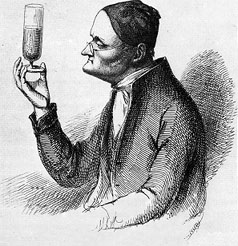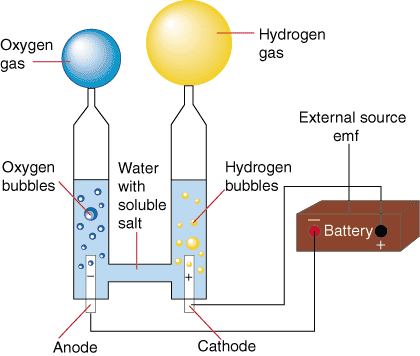Atoms / molecules / compounds

Madame Lavoisier (on the right) while assisting her husband, Antoine, and his assistant Armand Seguin (in suit, at left) on his scientific research of human respiration. Lavoisier recognized and named oxygen in 1778.
Before 1800 "natural philosophers" realized that...
- Many substances could be decomposed into other substances,
- A handful of substances could not decomposed. They called these the elements
John Dalton
 In the early 1800s John Dalton (a Quaker) noticed that one kind of tin oxide could be decomposed into
13.5 grams of oxygen for every 100 g of tin. Another kind could be decomposed into 27 grams of oxygen for every 100 g of tin.
In the early 1800s John Dalton (a Quaker) noticed that one kind of tin oxide could be decomposed into
13.5 grams of oxygen for every 100 g of tin. Another kind could be decomposed into 27 grams of oxygen for every 100 g of tin.
A simple integer ratio of 1:2.
Example of decomposition
 electrolysis of water
electrolysis of water
- Hook a battery with a voltage greater than ~1 Volt to the circuit pictured, and electricity flows.
- At each of the platinum electrodes bubbles form.
- But at one of them, *exactly* twice as much gas (by volume) accumulates as at the other one.
Electrolysis: 9V battery and thumbtacks
Atoms, the "ultimate particles..."
This could be explaind by atoms combining in definite ratios...
We now know the chemical formulae for the two tin oxides as SbO and SbO${}_2$.
John Dalton wrote:
Therefore we may conclude that the ultimate particles of all homogeneous bodies are perfectly alike in weight, figure, etc. In other words, every particle of water is like every other particle of water; every particle of hydrogen is like every other particle of hydrogen, etc.
Dalton thought that...
- Compounds can be decomposed into elements, so they are made of elements.
- An element consists of just one kind of atom.
- Atoms cannot be further decomposed, which is why they are "elemental".
- No atoms are ever created or destroyed. Chemical reactions are just re-arrangements of atoms into different compounds.
A molecule
...is a group of atoms (more than one) bound together by chemical bonds:
 For example, carbon dioxide is a gas of identical molecules, each of which has exactly 1 $C$ and 2 $O$ atoms: $CO_2$.
For example, carbon dioxide is a gas of identical molecules, each of which has exactly 1 $C$ and 2 $O$ atoms: $CO_2$.
 The atoms can be of the same element. For example, The oxygen in our atmosphere is almost all $O_2$ (oxygen gas) with trace amounts of $O_3$ molecules (ozone).
The atoms can be of the same element. For example, The oxygen in our atmosphere is almost all $O_2$ (oxygen gas) with trace amounts of $O_3$ molecules (ozone).
A pure compound consists of either
- A gas of identical molecules, or
- A liquid of identical molecules, or
 A solid in which all the atoms are bound to each other, with some definite ratio. For example, $GaAs$ is a solid with 1 atom of gallium for every 1 atom of arsenic.
A solid in which all the atoms are bound to each other, with some definite ratio. For example, $GaAs$ is a solid with 1 atom of gallium for every 1 atom of arsenic.
Which gases are GHGs?
The structure of a molecule has a lot to do with whether it is a greenhouse gas (GHG), which is mostly because these molecules absorb infrared radiation:
- All the single atom gases are not GHGs: E.g. $\color{green}He$ $\color{green}Ne$ $\color{green}Ar$ $\color{green}Xe$ .
- Most of the two-atom gases are not GHGs: E.g. $\color{green}N_2$, $\color{green}O_2$, $CO$ (very weak), except $\color{red}H_2$.
- Most 3-atom gases *are* GHGs, E.g. $\color{red}CO_2$ (weak but plentiful), $\color{red}H_2O$(*), $\color{red}N_2O$ (nitrous oxide), except $\color{green}SO_2$.
- Most 4-or-more-atom gases *are* GHGs, E.g. $\color{red}CH_4$ (methane), $\color{red}CCl_3F$ (CFC-11), $\color{red}SF_6$ (sulfur hexafluoride), but not $\color{green}NH_3$ (ammonia).
Why?
Dangling arms
Here's a water molecule. Its atoms can vibrate towards/away from each other. But so can the atoms in a two-atom molecule. But the hydrogens out there can also flex (rightmost picture). IR radiation is just the right frequency to excite this kind of flexing motion. And when it's excited, the molecule absorbs energy from infrared radiation.

Every atom is the same...
Nowadays, we describe electrolysis with a chemical reaction equation: $$2H_2O_{\text{(l)}} + \rightarrow 2H_\text{2 (g)} + \color{#ccc}{1}\color{black}O_\text{2 (g)}$$
- It's not like some hydrogen atoms are "bigger" than other hydrogen atoms, or some oxygens are "bigger" than other oxygens.
- It's not like some water molecules have one oxygen with 3,2,or 1 hydrogens.
- That 2:1 ratio of large quantities of gases given off by electrolysis is the same as the 2:1 ratio of the atoms in all the "water" molecules in the universe when you decompose them.
- That 2:1 ratio is not an average of many experiments. Every time you decompose water you get twice as much hydrogen as of oxygen
The hydrogen ($H_2$) and oxygen ($O_2$) gas that appear cannot be decomposed further into other substances, so we say that hydrogen and oxygen are "elements".
It takes energy (from the battery) to make this reaction happen. If you disconnect the battery, no more hydrogen or oxygen is produced. The reaction stops.
Study questions
- Name 3 GHGs present in Earth's Atmosphere.
- Name 3 common gasses in Earth's atmosphere which *are not* GHGs.
 Would you guess that $CCl_2F_2$ (molecular model at the right) is a GHG or not?
Would you guess that $CCl_2F_2$ (molecular model at the right) is a GHG or not?
Read
Read Hobson, Chapter 2
Conceptual exercises 2, 8, 10, 28, 44
Answers & clarifications
1.)
A "theory" in Hobson's definition is more than just a guess, but not (never) known for certain to be true. It is a set of well-tested ideas that have stood up to experimental tests so far. (That's the definition that Hobson gives of a theory.)
2.)
$C$ has atomic weight 12 g / mole,
$O$ has atomic weight 16 g / mole.
$\Rightarrow$ Weight ratios in...- $CO$ 12::16 = 3::4
$CO_2$ 12::2*16=12::32 = 3::88.)
Pure compounds (just one kind of compound): pure water, $H_2SO_4$
Elements (just one kind of atom): Oxygen, liquid $Hg$ (mercury), Uranium, $U$.
Neither: Air is mixture of several elemental gases (e.g. $N_2$, $O_2$) and compound gases (e.g. $CO_2$ and $NO_2$).
10.)
All the elements in the same column of the periodic table have the same chemical properties. Other elements in $He$'s column include: Argon, Krypton, Neon, Xenon, and Radon
28.)
Many molecules in the atmosphere moving randomly + "collectively" (= "on average") towards the East:
This is commonly referred to as the wind.
44.)
$NO_2$ is made up of Nitrogen and Oxygen.
Image credits